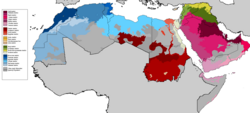Languages
Main article: Languages of Morocco

An overview of the different Arabic dialects
About 2 million[citation needed] Moroccans in the northern part of the country speak Spanish as a second language in parallel with Riff. English, while still far behind French and Spanish in terms of number of speakers, is rapidly becoming the second foreign language of choice among educated youth. As a result of national education reforms entering into force in late 2002, English will be taught in all public schools from the fourth year on. French is still taught nationally from the earliest grades.
The single oldest known native language of Morocco is the Berber language. Its current number of speakers is unknown. The government avoids highlighting this issue for political reasons. Berber in Morocco has Two main accents or varieties: Tamazight Tarifit, the Moroccan Atlas Tamazight of (All Atlas Mountains, Morocco), was referred to as Tashelhit.
Contrary to stereotypical beliefs held by many foreigners, Berber-speaking Moroccans live in the cities too and not only in rural areas. The cities of Casablanca and Rabat, for example, have sizable Berber-speaking populations that might amount to a third or more of their total respective populations.
The number of Tamazight-Tarifit speakers was estimated at around 3 million in 1990.[61] The language is spoken in the Rif area in the north of the country, and is the largest Berber dialect in Morocco, by number of speakers. There is also 2 million Riff-speaking in Europe. The Riffians represent over 96% of the Morrocans in The Netherlands and Belgium. and 45% of the Morroccans in France are Riffian. The High Atlas Region Tamazight dialect is the most widely spoken variety of Berber, as it covers the whole of the Region High Atlas Mountains, including greater external Mountains referred to as Jbel Atlas Saghru or Little Atlas. Studies done in 1990 show around 3 million people, concentrated in the central south of Morocco, speak Tamaizght (was referred to as Tashelhit).[61]
Linguistically, Berber belongs to the Afro-Asiatic languages group, and has many accents or variants. Collectively, these are known by many Moroccan-Arabic-speakers as "Shelha". Classical Arabic of the Middle East still uses the word "Barbaria". Although, there is an increasing tendency by Arab Media (e.g. Aljazeera, Asharq Alawsat) to use the word "Amazighiyya" because the Arabic word "Barbari" means both "Berber" and "Barbarian". The terms "Barbar" and "Shelha" (or "Shalha") are considered by most Berber activists to be offensive. They prefer the word Amazigh. However, the European word "Berber" is not considered offensive by Berbers because European languages distinguish between "Berber" and "Barbarian".
Aucun commentaire:
Enregistrer un commentaire